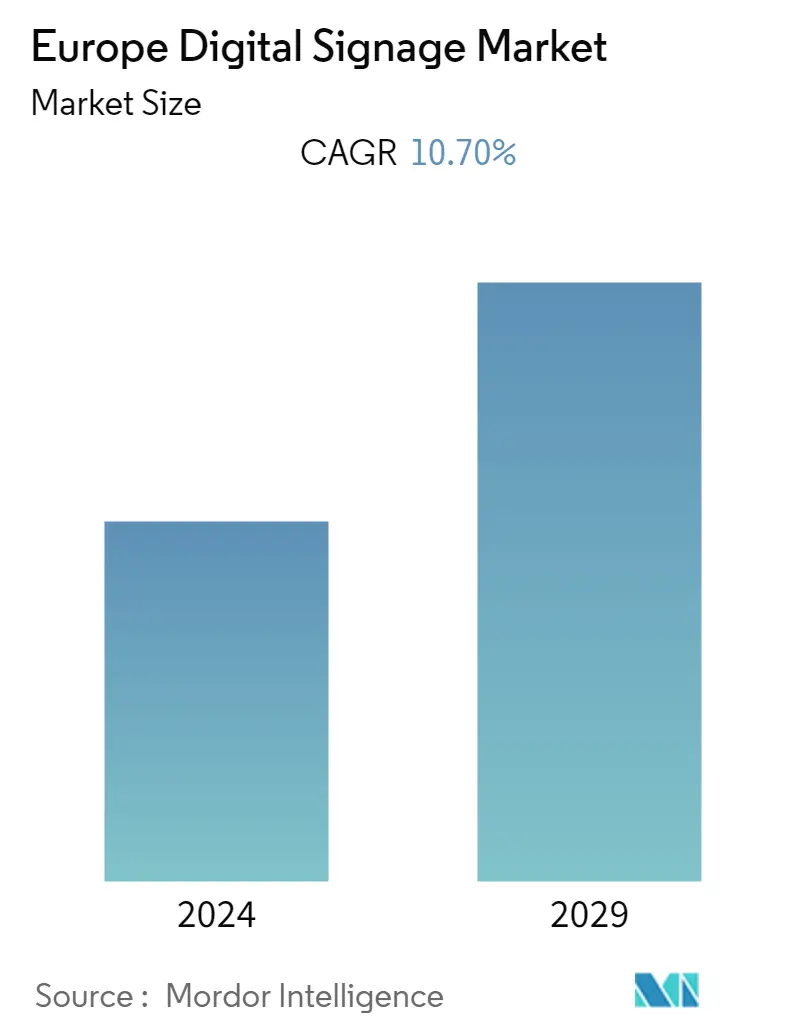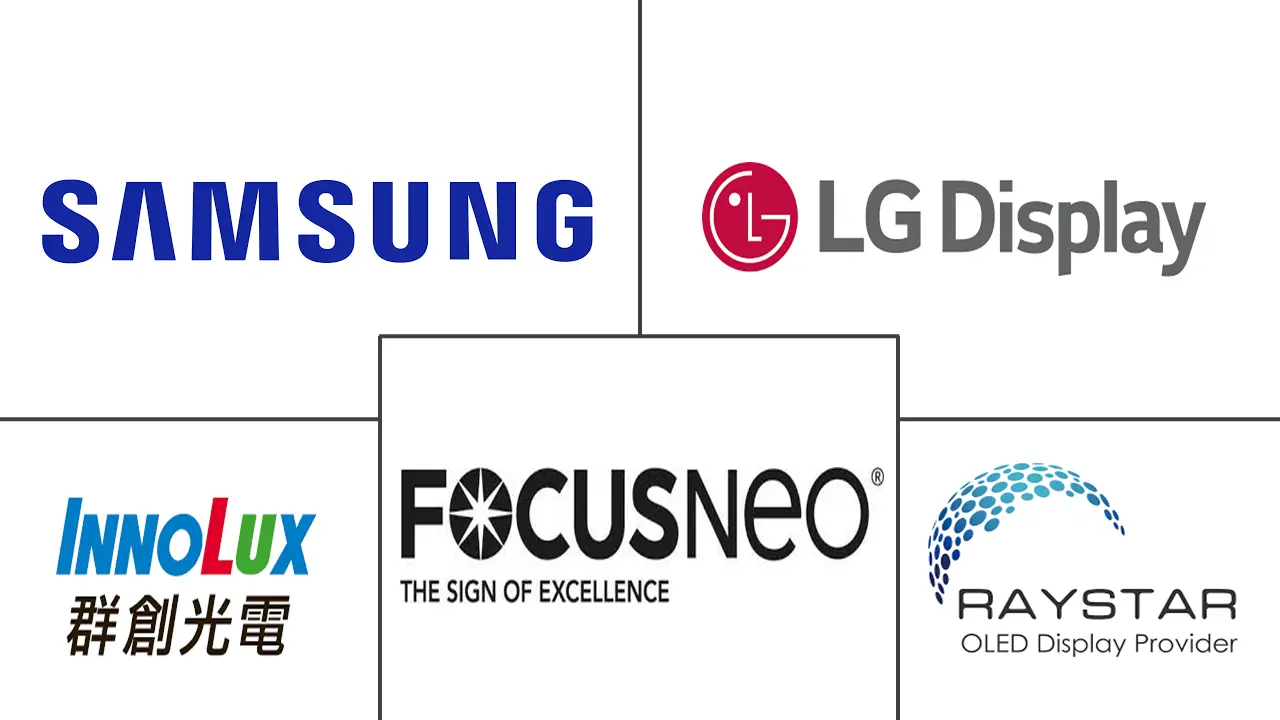Market Size of Europe Digital Signage Industry

| Study Period | 2019 - 2029 |
| Base Year For Estimation | 2023 |
| Forecast Data Period | 2024 - 2029 |
| Historical Data Period | 2019 - 2022 |
| CAGR | 10.70 % |
| Market Concentration | Low |
Major Players
*Disclaimer: Major Players sorted in no particular order |
Europe Digital Signage Market Analysis
The European Digital Signage market will register a CAGR of 10.7% during the forecast period. Digital signage is when audio-visual content, such as news, alerts, wayfinding information, commercial content, or emergency messages, is dynamically broadcast via digital medium to multiple screens in various locations. Digital signage systems eliminate frequent compatibility and interoperability issues between media players and displays. Furthermore, digital signage boards are being extensively used as arrival and departure boards in airports, known as Flight Information Display Systems (FIDS).
- The growth in transport networks, public infrastructure, and new commercial buildings, particularly in developing economies, creates more opportunities in this market. Digital signage is being used in and on all modes of public transportation to attract the attention of on-the-go viewers, providing real-time location and context awareness related to traveler information and advertising. Moreover, it is fast becoming a standard in many educational facilities, with schools and corporate campuses facilitating digital signage systems.
- The added benefits of digital signage are also driving its demand. Further, digital signage enables regional vendors to change displays and messages more quickly and effectively. Additionally, it is easy to manage when compared to traditional advertisements. Digital signs offer real-time information on products and availability, interactive data, and visually enticing photos and videos. Also, digital signage technology provides a high return on investments. It lets users control signage from any browser-based link and integrate signage into an existing IT network without replacing equipment.
- The growing demand across various industries also drives innovation in digital signage technology. For instance, according to Tele2IoT, delivering content to displays over cellular networks has become increasingly attractive compared to using limited LAN, and WiFiconnections, especially in areas where access to LAN or WiFi is limited. By empowering such ideas, digital displays can be installed anywhere cellular networks exist. A SIM-enabled display solution can also help reduce the cost and complexity for the user or end customer.
- Moreover, Increasing expenditure by leading retailers and product suppliers on online and broadcast advertisements is expected to hinder market growth, as the number of individuals using the internet across the region is increasing.
- Digital signage is one of the best solutions to reduce the risk of COVID-19 in crowded areas. It can be used for educating visitors, such as providing sanitizing gel or balancing the number of visitors in a venue by directing the crowd and implementing a headcount-based gateway to avoid crowded stores.
Europe Digital Signage Industry Segmentation
Digital signage is a display technology showing text, images, and videos. It uses LCD, LED, projection, and e-paper to display digital advertisement content. Digital signage are intended to send a specific message to a particular set of people.
The European Digital Signage market is segmented by Type (Hardware (LCD/LED Display, OLED Display, Media Players, Projectors/Projection Screens), Software, Services), End-user Vertical (Retail, Transportation, Hospitality, Corporate, Education, Government), and Country. The market sizes and forecasts are provided in terms of value (USD million) for all the above segments.
| By Type | |||||||
| |||||||
| Software | |||||||
| Services |
| By End-user Vertical | |
| Retail | |
| Transportation | |
| Hospitality | |
| Corporate | |
| Education | |
| Government | |
| Other End-user Verticals |
| By Country | ||||
| ||||
| ||||
| ||||
| ||||
| ||||
|
Europe Digital Signage Market Size Summary
The European digital signage market is experiencing significant growth, driven by the increasing adoption of digital displays across various sectors such as transportation, education, and retail. Digital signage systems, which broadcast audio-visual content dynamically across multiple screens, are becoming essential in enhancing communication and engagement in public spaces. The market is benefiting from the expansion of transport networks and public infrastructure, particularly in developing economies, where digital signage is used to provide real-time information and advertising in public transportation. Additionally, the technology is gaining traction in educational institutions and corporate campuses, offering a modern solution for information dissemination. The ease of management and the ability to deliver real-time, interactive content are key factors propelling the demand for digital signage, as it offers a high return on investment and integrates seamlessly into existing IT networks.
In the retail sector, digital signage is transforming customer experiences by enabling personalized and engaging in-store communications. Retailers are increasingly investing in digital displays to enhance their storefronts and provide tailored messages to consumers, thereby gaining a competitive edge over traditional advertising methods. The market is characterized by a mix of major global players and specialized software providers, offering a range of hardware and software solutions to meet diverse customer needs. Partnerships and innovations, such as those by SpinetiX SA and Broadsign, are further expanding the capabilities and reach of digital signage solutions. Despite the challenges posed by the rise of online and broadcast advertisements, the demand for digital signage continues to grow, supported by its ability to adapt to the evolving digital landscape and meet the needs of various industries across Europe.
Europe Digital Signage Market Size - Table of Contents
-
1. MARKET INSIGHTS
-
1.1 Market Overview
-
1.2 Industry Attractiveness - Porter's Five Forces Analysis
-
1.2.1 Bargaining Power of Suppliers
-
1.2.2 Bargaining Power of Consumers
-
1.2.3 Threat of New Entrants
-
1.2.4 Threat of Substitutes Products
-
1.2.5 Intensity of Competitive Rivalry
-
-
1.3 Distribution Channel Analysis
-
1.4 Industry Value Chain Analysis
-
1.5 Assessment of the Impact of the COVID-19 Pandemic on the Market
-
-
2. MARKET SEGMENTATION
-
2.1 By Type
-
2.1.1 Hardware
-
2.1.1.1 LCD/LED Display
-
2.1.1.2 OLED Display
-
2.1.1.3 Media Players
-
2.1.1.4 Projectors/Projection Screens
-
2.1.1.5 Other Hardware
-
-
2.1.2 Software
-
2.1.3 Services
-
-
2.2 By End-user Vertical
-
2.2.1 Retail
-
2.2.2 Transportation
-
2.2.3 Hospitality
-
2.2.4 Corporate
-
2.2.5 Education
-
2.2.6 Government
-
2.2.7 Other End-user Verticals
-
-
2.3 By Country
-
2.3.1 United Kingdom
-
2.3.1.1 Market Sizing and Trends
-
2.3.1.2 List of System Integrators
-
-
2.3.2 Germany
-
2.3.2.1 Market Sizing and Trends
-
2.3.2.2 List of System Integrators
-
-
2.3.3 France
-
2.3.3.1 Market Sizing and Trends
-
2.3.3.2 List of System Integrators
-
-
2.3.4 Italy
-
2.3.4.1 Market Sizing and Trends
-
2.3.4.2 List of System Integrators
-
-
2.3.5 Belgium
-
2.3.5.1 Market Sizing and Trends
-
2.3.5.2 List of System Integrators
-
-
2.3.6 Rest of Europe
-
2.3.6.1 Market Sizing and Trends
-
2.3.6.2 List of System Integrators
-
-
-
Europe Digital Signage Market Size FAQs
What is the current Europe Digital Signage Market size?
The Europe Digital Signage Market is projected to register a CAGR of 10.70% during the forecast period (2024-2029)
Who are the key players in Europe Digital Signage Market?
Samsung Display Solutions (Samsung Electronics Co. Ltd), LG Display Co. Ltd, Innolux Corp., FocusNeo AB and Raystar Optronics Inc. are the major companies operating in the Europe Digital Signage Market.

